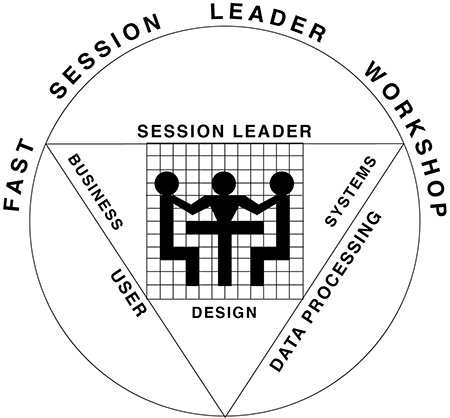January 1998

Tools and More Tools | Gary Rush, IAF CPF
This article discusses three new tools. I gathered these from the students at our Advanced Class in November and from my session at the IAF Conference in Santa Clara in January. The tools have a lot of potential. These tools are used mostly in planning, visioning, and scope-defining workshops, but can be used whenever you feel the problem warrants. The tools are: "Building on Each Other", "House Building", and "Metaphors". Each is described below.
"Building on Each Other"
Objectives: To help participants recognize the value of cooperation, diversity, and each other's contribution.
Uses: Use this when you have a slightly dysfunctional group and need to reinforce cooperation. Also use this to illustrate the value of diversity - at the beginning of a project or a plan. It brings out more Strengths while doing "Strengths, Weaknesses, Threats, and Opportunities" (SWOT) Analysis.
Materials: For each group, you need paper for drawing at tables or flip charts for drawing standing up. You also need markers and tape.
Instructions: Do this as one large group or numerous smaller groups of about 4 or 5 people. Tell the group to build one picture of their vision or who they are. Each group member draws a part of the picture - each one, one at a time, contributing something to the overall picture. Each contributes something that represents what they have to offer the group or organization. At the end, review the final picture and have the participants add words - what do they see?
Debrief: Discuss what they see. Did they learn anything from the exercise? Was there value in having everyone contribute? What was it? Write the ideas onto a flip chart and hang it on the wall. Use the final picture or pictures as reference in the subsequent steps.
"House Building"
Objectives: To illustrate the need for team cooperation. To help develop a group vision. To build a physical metaphor to facilitate building a plan.
Uses: Use this when you want to reinforce the need for cooperation, develop a group vision, build a strategic plan, or build a project plan. The house that is built, can physically hold and represent the plan.
Materials: You need cardboard and construction paper, scissors, and tape at a minimum. You can add any other materials that may help in constructing a model home.
Instructions: This exercise takes 1 to 2 hours. Break the group into equal teams of no more than 5 people. Provide them with enough materials to build a home. Decide whether you want them to focus on the process or the results and emphasize process or results in the instructions. Tell them to:
- Define the process to design and construct a home.
- Design the home.
- Use the materials to construct the home that they designed.
- Each team presents their house and process
Debrief: Talk through the process and the results. Discuss the lessons - team building, understanding the process before jumping in, knowing and building a foundation before the rest of the structure, etc.. Use the final houses as metaphors for the vision - blueprints are the vision; parts of the house become components of the vision; the process becomes the strategies; etc. - and the components actually documented onto the house.
"Metaphors"
Objectives: To help overcome barriers to developing visions or ideas.
Uses: Use this when developing a vision or a plan and the group is having difficulty grasping the concepts.
Materials: Flip charts and markers.
Instructions: Instead of building a vision and a plan to achieve the vision for a group, have the group describe a different situation that can be used as a metaphor. Examples of metaphor uses are:
One group drew a picture of a mountain and the road to the top. The peak represented the vision; the road was the path (strategies) to get there; obstacles were critical success factors. Another group used baking a pie as the metaphor for a vision - the pie was the vision, the recipe as the strategy, the pots and utensils as the tools needed, the chef as the resources, and the ingredients as the raw materials.
Debrief: Discuss what the group learned and have them apply their metaphor to the task at hand. Ask how the metaphor helps them understand what they are doing in the workshop.
Summary
The tools listed above help facilitators when they are appropriate. Most deal with higher level problems - visioning and team building - but can be used in any situation that may benefit. The key is to ensure that the situation warrants a corrective action. Let me know if you found any that were particularly useful to you. ![]()

